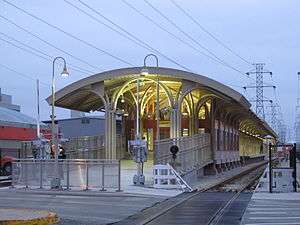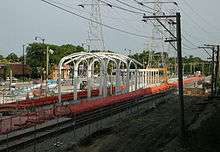Oakton–Skokie station
Oakton–Skokie is an 'L' station on the CTA's Yellow Line, which serves downtown Skokie. Previously, a station existed at this location which was in operation as part of the North Shore Line's Niles Center Route from 1925 until 1948, and later demolished in 1964. The current station opened on April 30, 2012.[2]
Oakton–Skokie 8000N 4800W | ||||||||||||||||||||||||||||||||||||||||||||||||||||||||||||||||||||||||||||||||||||||||
|---|---|---|---|---|---|---|---|---|---|---|---|---|---|---|---|---|---|---|---|---|---|---|---|---|---|---|---|---|---|---|---|---|---|---|---|---|---|---|---|---|---|---|---|---|---|---|---|---|---|---|---|---|---|---|---|---|---|---|---|---|---|---|---|---|---|---|---|---|---|---|---|---|---|---|---|---|---|---|---|---|---|---|---|---|---|---|---|---|
| Chicago 'L' rapid transit station | ||||||||||||||||||||||||||||||||||||||||||||||||||||||||||||||||||||||||||||||||||||||||
 The main entrance to Oakton–Skokie in 2012 | ||||||||||||||||||||||||||||||||||||||||||||||||||||||||||||||||||||||||||||||||||||||||
| Location | 4800 Oakton Street Skokie, Illinois 60076 | |||||||||||||||||||||||||||||||||||||||||||||||||||||||||||||||||||||||||||||||||||||||
| Coordinates | 42.0273°N 87.7476°W | |||||||||||||||||||||||||||||||||||||||||||||||||||||||||||||||||||||||||||||||||||||||
| Owned by | Village of Skokie | |||||||||||||||||||||||||||||||||||||||||||||||||||||||||||||||||||||||||||||||||||||||
| Line(s) | Skokie Swift | |||||||||||||||||||||||||||||||||||||||||||||||||||||||||||||||||||||||||||||||||||||||
| Platforms | 1 island platform | |||||||||||||||||||||||||||||||||||||||||||||||||||||||||||||||||||||||||||||||||||||||
| Tracks | 2 tracks | |||||||||||||||||||||||||||||||||||||||||||||||||||||||||||||||||||||||||||||||||||||||
| Connections | CTA and Pace buses | |||||||||||||||||||||||||||||||||||||||||||||||||||||||||||||||||||||||||||||||||||||||
| Construction | ||||||||||||||||||||||||||||||||||||||||||||||||||||||||||||||||||||||||||||||||||||||||
| Structure type | At-grade | |||||||||||||||||||||||||||||||||||||||||||||||||||||||||||||||||||||||||||||||||||||||
| Bicycle facilities | yes | |||||||||||||||||||||||||||||||||||||||||||||||||||||||||||||||||||||||||||||||||||||||
| Disabled access | Yes | |||||||||||||||||||||||||||||||||||||||||||||||||||||||||||||||||||||||||||||||||||||||
| History | ||||||||||||||||||||||||||||||||||||||||||||||||||||||||||||||||||||||||||||||||||||||||
| Opened | March 28, 1925 | |||||||||||||||||||||||||||||||||||||||||||||||||||||||||||||||||||||||||||||||||||||||
| Closed | March 27, 1948 – April 30, 2012 | |||||||||||||||||||||||||||||||||||||||||||||||||||||||||||||||||||||||||||||||||||||||
| Rebuilt | 2010–12 | |||||||||||||||||||||||||||||||||||||||||||||||||||||||||||||||||||||||||||||||||||||||
| Previous names | Oakton | |||||||||||||||||||||||||||||||||||||||||||||||||||||||||||||||||||||||||||||||||||||||
| Traffic | ||||||||||||||||||||||||||||||||||||||||||||||||||||||||||||||||||||||||||||||||||||||||
| Passengers (2019) | 274,960[1] | |||||||||||||||||||||||||||||||||||||||||||||||||||||||||||||||||||||||||||||||||||||||
| Rank | 135 out of 143 | |||||||||||||||||||||||||||||||||||||||||||||||||||||||||||||||||||||||||||||||||||||||
| Services | ||||||||||||||||||||||||||||||||||||||||||||||||||||||||||||||||||||||||||||||||||||||||
| ||||||||||||||||||||||||||||||||||||||||||||||||||||||||||||||||||||||||||||||||||||||||
| ||||||||||||||||||||||||||||||||||||||||||||||||||||||||||||||||||||||||||||||||||||||||
| ||||||||||||||||||||||||||||||||||||||||||||||||||||||||||||||||||||||||||||||||||||||||
History
In the 1920s, both the Chicago Rapid Transit Company and the North Shore Line (an interurban railroad linking Chicago and Milwaukee) existed under the private ownership of Samuel Insull. The North Shore Line's original route to Milwaukee ran through numerous North Shore communities that had become densely settled. In order to provide faster service between Chicago and Milwaukee, the North Shore Line decided to build a high-speed bypass several miles west of its original line. The new route would traverse the Skokie Valley and converge with the 'L' at Howard. In an attempt to encourage development in the village of Niles Center on the southern portion of the line, the Chicago Rapid Transit Company would operate rapid transit service as far as Dempster Street.
The new "Niles Center Route" included several intermediate stations served only by the Chicago Rapid Transit Company, including one at Oakton Street, just a few blocks from the intersection of Lincoln Avenue and Oakton Street where the business district of Niles Center was forming. Arthur U. Gerber, staff architect for Samuel Insull, designed the station in the Prairie School style, similar to the Dempster station at the end of the line. The station at Oakton was smaller and set between the tracks, with a single high-level island platform projecting from the rear of the station house.
The line entered operation on March 28, 1925, but did not encourage much development before the Great Depression and World War II put a halt to building activity for nearly 20 years. The Niles Center service remained unprofitable in 1947 when the privately owned Chicago Rapid Transit Company was subsumed into the public Chicago Transit Authority, and on March 27, 1948, rapid transit service was terminated and replaced by the 97 Skokie bus route. All rapid transit stations along the line were closed, except for Dempster where North Shore Line service continued until the company went out of business in 1963.
On Monday, April 20, 1964, the Chicago Transit Authority reinstated service on the Niles Center Branch as a nonstop shuttle between Howard and Dempster, dubbed the Skokie Swift. No station was located at Oakton, even though it is only one block from Skokie's central business district.
Reconstruction

Since the Swift began operating in 1964, there has been interest on the part of the Village of Skokie and its citizens to reestablish at least one of the local stations. The most likely candidate to return was Oakton because of its location near Skokie's downtown and its potential to generate the most traffic. A study commissioned by the Village of Skokie and completed in Fall 2003 recommended establishing a stop at Oakton. Village officials discussed and planned for a downtown Skokie Swift station for more than five years. More recently, a developer purchased the 28-acre (110,000 m2) Pfizer Pharmaceuticals property adjacent to the station site to build a life sciences research park, now Illinois Science + Technology Park. The employees at the research park would drive ridership at the station. The CTA has supported plans for the Oakton station, as indicated in a 2003 letter from then CTA President Frank Kruesi: "By... providing infill stations (along the Yellow Line), the CTA will make better use of existing service capacity and provide expanded reverse commute opportunities."
Style and design
In early 2005, the village received $417,000 in a federal grant earmarked for the station's design, which covers about 80 percent of design costs for the station. The village would pick up the remainder, about $104,000, according to Village Director of Engineering Fred Schattner. Then, in mid-2005, village staff submitted a grant proposal to the federal Congestion Mitigation and Air Quality grant program, which provides funds for projects that contribute to traffic congestion relief and cleaner air quality. In late November 2005, the Skokie secured a $1 million federal grant for the village's downtown Skokie Swift project with the help of U.S. Rep. Jan Schakowsky, D-9th. Then, in early December 2005, Skokie learned they would receive an additional $9.2 million in federal grant funds to construct the station. The entire project is estimated to cost about $15 million including any land acquisition needed, which means the village had by this time secured more than two-thirds of the funding. Skokie Mayor Van Dusen has said he is exploring options to help pay for some or all of the remaining cost.
Location
The station is located on the site of the original station, just west of Skokie Boulevard, north of Oakton Street and adjacent to the new Illinois Science + Technology Park. The village sought proposals from firms for design work for the new station, eventually awarding the contract to McDonough Associates. Construction of the new downtown station was expected to begin in 2007 and officials estimated the station would be completed in 2007 or 2008. Issues of financing delayed the project as various funding sources were secured, and later issues of land acquisition delayed the project further. Finally in 2007 after extensive deliberation, the Village of Skokie initiated eminent domain proceedings against two landowners (an auto repair shop and a truck rental business) to make room adjacent to the station for a "kiss and ride" area, a bus turnaround and a taxi drop-off area.
A groundbreaking ceremony took place at the adjacent Illinois Science + Technology Park on June 21, 2010.[3] On June 8, 2011, the Chicago Transit Board revealed that the name of the station would be Oakton–Skokie. Naming of the station was done concurrently with the renaming of the Dempster–Skokie Yellow Line station and terminus.[4]
Facilities
The station consists of an island platform at grade level located between the Yellow Line's two tracks; the eastern track serves trains to Dempster–Skokie, while the western track serves trains to Howard. Oakton–Skokie has two entrances: one located off of Oakton Street and the other off Skokie Boulevard near Searle Parkway.[5]
Bus connections
- 54A North Cicero/Skokie Blvd (Weekday Rush Hours only)
- 97 Skokie
- 210 Lincoln Avenue
Notes and references
Notes
References
- "Monthly Ridership Report – December 2019" (PDF). Chicago Transit Authority, Ridership Analysis and Reporting. January 13, 2020. Retrieved March 19, 2020.
- "Oakton–Skokie Yellow Line Station Opens". Chicago Transit Authority. April 30, 2012. Retrieved April 30, 2012.
- Isaacs, Mike (June 21, 2010). "Downtown Skokie station breaks ground". Skokie Review. Skokie, Illinois. Retrieved June 25, 2010.
- "CTA Changes Existing Yellow Line Station Name, Announces Names of New Yellow, Green/Pink Stations" (Press release). Chicago Transit Authority. Retrieved June 9, 2011.
- "New Oakton Station". Chicago Transit Authority. Archived from the original on September 1, 2010. Retrieved July 4, 2011.
External links
| Wikimedia Commons has media related to Oakton-Skokie (CTA). |